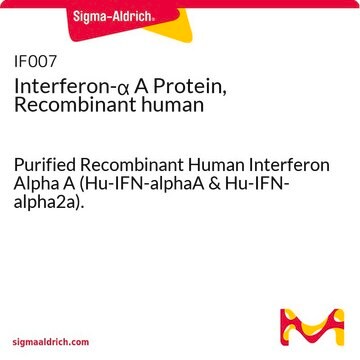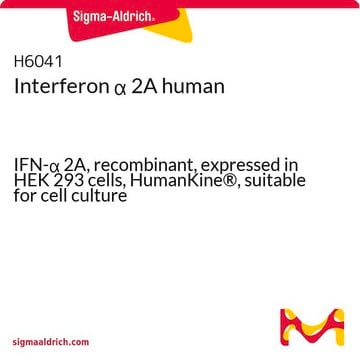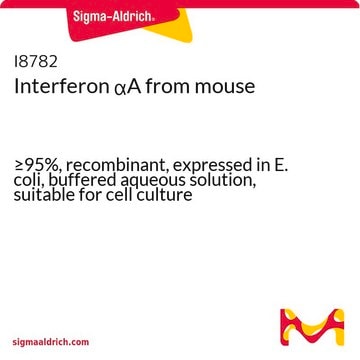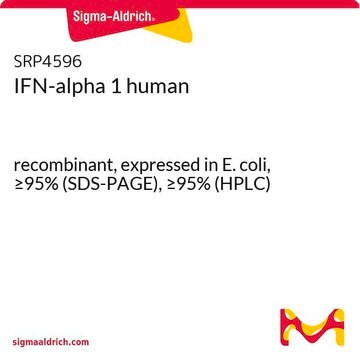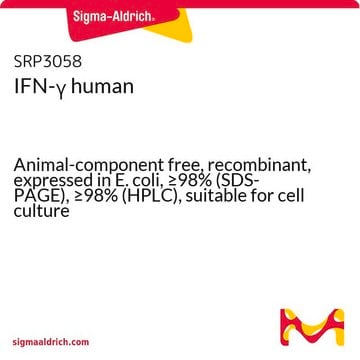I4401
Interferon-αA/D human
≥95%, recombinant, expressed in E. coli, buffered aqueous solution, suitable for cell culture
Synonym(s):
IFN-αA/D
Sign Into View Organizational & Contract Pricing
All Photos(1)
About This Item
Recommended Products
biological source
human
Quality Level
recombinant
expressed in E. coli
Assay
≥95%
form
buffered aqueous solution
mol wt
19 kDa
packaging
pkg of 100K units
technique(s)
cell culture | mammalian: suitable
impurities
endotoxin, tested
color
colorless
UniProt accession no.
shipped in
dry ice
storage temp.
−70°C
Gene Information
human ... IFNA2(3440)
Application
Interferon-αA/D human has been used:
- for identification of coronavirus replicase inhibitors
- in combination with ACH-806 [1-(4-pentyloxy-3-trifluoromethylphenyl)-3-(pyridine-3-carbonyl)thiourea] to study the effect on hepatitis C virus (HCV) replication
- in combination with vitamin D to check reduction in HCV protein production in cell culture
Biochem/physiol Actions
Interferon-αA/D (Bg/II), also known as Universal Type I Interferon, is an α interferon hybrid that crosses the species barrier. The Bg/II denotes the restriction enzyme site from which this hybrid is constructed from recombinant human interferons αA and αD. Interferon-αA/D has been proven to be active on many mammalian cells. It can substitute for human, monkey, mouse, bovine, rat, cat, dog, rabbit, sheep, goat, horse, pig or hamster type I interferon (α, β, ω and τ). Type I Interferons are a closely related family of 165-172 amino acid proteins that are produced by leukocytes (α subtypes), fibroblasts (β subtypes), lymphocytes (ω subtypes), and ruminant embryos (τ subtypes). This cytokine has anti-viral, anti-proliferative, immunoregulatory, and proinflammatory activities.
Physical form
Solution in phosphate buffered saline containing 0.1% bovine serum albumin
Analysis Note
The biological activity is determined in the cytopathic effect inhibition assay using MDBK cells with vesicular stomatitis virus (VSV). A cytopathic effect of 50% is produced with 1 unit/ml interferon. The units are determined with respect to NIH international standard reference for human interferonαA.
Storage Class Code
10 - Combustible liquids
WGK
WGK 3
Flash Point(F)
Not applicable
Flash Point(C)
Not applicable
Personal Protective Equipment
dust mask type N95 (US), Eyeshields, Gloves
Certificates of Analysis (COA)
Search for Certificates of Analysis (COA) by entering the products Lot/Batch Number. Lot and Batch Numbers can be found on a product’s label following the words ‘Lot’ or ‘Batch’.
Already Own This Product?
Find documentation for the products that you have recently purchased in the Document Library.
Customers Also Viewed
Hector Moreno et al.
Viruses, 13(7) (2021-08-11)
The New World (NW) mammarenavirus group includes several zoonotic highly pathogenic viruses, such as Junin (JUNV) or Machupo (MACV). Contrary to the Old World mammarenavirus group, these viruses are not able to completely suppress the innate immune response and trigger
David L Wyles et al.
Antimicrobial agents and chemotherapy, 52(5), 1862-1864 (2008-03-12)
Rapid emergence of resistance to monotherapy with virus-specific inhibitors necessitates combination therapy. ACH-806 is a hepatitis C virus NS4A inhibitor with a novel mechanism of action and resistance pathway. This compound was synergistic with NS3 protease inhibitors and NS5B nucleoside
Julio A Gutierrez et al.
Journal of virology & antiviral research, 3(3), doi:10-doi:10 (2015-11-26)
Previous studies suggest that low serum 25-hydroxyvitamin D [25(OH) D] levels are associated with reduced responsiveness to interferon and ribavirin therapy. We investigated the impact of vitamin D metabolites on HCV and cellular gene expression in cultured hepatoma cells. HCV
Sophie Rogée et al.
Antiviral research, 161, 1-9 (2018-10-28)
Rabies virus transmits from animals to humans and causes encephalitis. Every year more than 15 million people receive a post exposure prophylaxis (PEP) treatment that is highly effective in the prevention of rabies disease. However, when clinical symptoms appear, for
Pathompong Bowornruangrit et al.
Medical sciences (Basel, Switzerland), 10(1) (2022-03-25)
Autophagy is a known mechanism of cells under internal stress that regulates cellular function via internal protein recycling and the cleaning up of debris, leading to healthy live cells. However, the stimulation of autophagy by external factors such as chemical
Our team of scientists has experience in all areas of research including Life Science, Material Science, Chemical Synthesis, Chromatography, Analytical and many others.
Contact Technical Service
